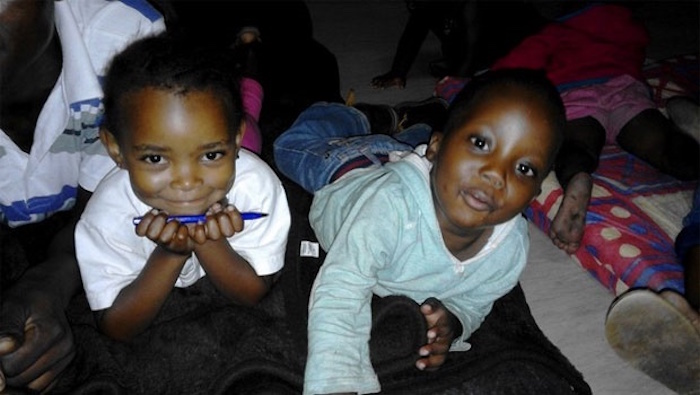Walking into the Masiphumelele community hall, the noise of children crying and chatter between their parents welcomed visitors. The room was cold and dim. The people staying there do not know whether the lights work or not. There were mattresses laid on the floor.
In one corner the residents have packed black plastic bags where they keep their clothes. A woman is searching through a plastic bag looking for something to sleep in.
These children have been living in the Masiphumelele Community Hall for months following a fire in late November 2015 that left thousands homeless. (Thembela Ntongana, GroundUp)
GroundUp reported in January that there were 250 people living at the community hall. They lost their homes in the fire of late November 2015 that destroyed 1 000 shacks and left 4 000 people homeless.
Since then the City of Cape Town had provided shacks for 18 people and others had decided to look for alternative places to stay. Some moved in with friends and families, tired of sleeping on the cold floor of the community hall.
There are just under 40 residents still living in the hall. They have nowhere else to go.
Not safe
Lulama Jack has handed her 8-year old twin boys to a relative. She said she would rather not have them stay with her and live in the cold community hall. Jack doesn’t have a full time job. She is sometimes called a few times a week to work as a domestic worker.
“I do not like the fact that they are not here with me but this place is not safe and some people are sick. We had to force someone to go to the hospital just last week because he had TB and was not treating it. There are kids here as young as 4 months.”
She said the mattresses were so thin you could feel the cold floor. The door of the hall was always open, so people walked in and out continuously. Jack said that on weekends drunk people walk in to use the toilets.
“This is no place for anyone and it is definitely no place for children to stay,” she said.
Jack said if the City provided them with a place to build they would move out of the hall.
“We are not here because we like it. We want to move out to our own places so we can stay with our children. This has divided many families,” said Jack.
Another resident, Singalakha Nongawuza, said she believed the City had forgotten about them. “We have to remind them that we are here. I have been going to the councillor’s office to remind her that we are here. This is not a good place for anyone to stay,” she said.
‘Next week’
“Every time they say ‘next week’. It’s been three months now. There are 39 people here but the City tells us that they only have 13 people. We do not know whose name is not there. We are worried what will happen to the ones whose names are not there because we are all fire victims,” said Nongawuza.
She added that some of them had been told they were not fire victims but backyarders who are there to benefit.
“Who would want to live like this if they have a place to stay? Every day that goes by some of us lose hope of ever getting a place,” said Nongawuza.
The hall residents described how even people from the community were angry with them because they were unable to get their social grants from the hall and have to go to neighbouring Ocean View township.
But on Tuesday morning they were woken up at 05:00 by people from social services so that grants could be distributed. Vellem Vutha said they had to sit outside to wait for the grant distribution process to finish.
Vutha said his shack was demolished by the City who took all of his building materials. He said he was told that he had built in a place where he was not supposed to.
“I am not asking for much. I just want a place to stay. We have been here for too long. I am scared to put up a shack because it might be demolished again,” said Vutha.
Planners looking at options
City of Cape Town mayoral committee member for human settlements, Benedicta van Minnen, said city planners were looking at various options to see how residents can be accommodated. She said when ready, the proposed layout would be discussed with Masiphumelele’s leadership and the affected households.
The fires occurred in Masiphumelele’s areas D and E, which have since been rebuilt. Van Minnen said these areas were now occupied to capacity.
“The City tried to reorganise the layout to accommodate all of the original fire-affected residents to improve the walkways between the structures for the provision of basic services and also to establish fire breaks to enhance safety,” she explained.
“No further erection of structures can be allowed as this leads to increased density, which will make access to basic and emergency service provision challenging. It will also increase health, flood and fire risks,” said Van Minnen.
She added that currently the remaining wetland areas around these sites are dry, which is enticing the erection of structures. But this could not be allowed, she said, as the area is flood-prone and it would be disastrous for these residents when the rains come.
[Source: News24]





 WhatsApp us
WhatsApp us 

